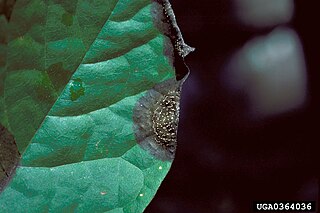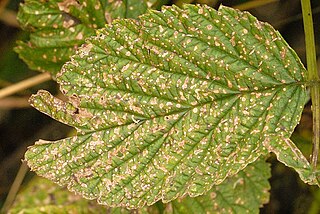Related Research Articles

Phomopsis cane and leaf spot occurs wherever grapes are grown. Phomopsis cane and leaf spot is more severe in grape-growing regions characterized by a humid temperate climate through the growing season. Crop losses up to 30% have been reported to be caused by Phomopsis cane and leaf spot.

Cercospora is a genus of ascomycete fungi. Most species have no known sexual stage, and when the sexual stage is identified, it is in the genus Mycosphaerella. Most species of this genus cause plant diseases, and form leaf spots. It is a relatively well-studied genus of fungi, but there are countless species not yet described, and there is still much to learn about the best-known members of the genus.
Glomerella graminicola is an economically important crop parasite affecting both wheat and maize where it causes the plant disease Anthracnose Leaf Blight.

Colletotrichum acutatum is a plant pathogen and endophyte. It is the organism that causes the most destructive fungal disease, anthracnose, of lupin species worldwide. It also causes the disease postbloom fruit drop on many varieties of citrus, especially Valencia and navel oranges in Florida.

Lasiodiplodia theobromae is a plant pathogen with a very wide host range. It causes rotting and dieback in most species it infects. It is a common post harvest fungus disease of citrus known as stem-end rot. It is a cause of bot canker of grapevine. It also infects Biancaea sappan, a species of flowering tree also known as Sappanwood.
Curvularia senegalensis is a fungal plant pathogen.
Denticularia mangiferae is an ascomycete fungus that is a plant pathogen.
Sporisorium reilianum Langdon & Full., (1978), previously known as Sphacelotheca reiliana, and Sporisorium reilianum, is a species of biotrophic fungus in the family Ustilaginaceae. It is a plant pathogen that infects maize and sorghum.

Colletotrichum coccodes is a plant pathogen, which causes anthracnose on tomato and black dot disease of potato. Fungi survive on crop debris and disease emergence is favored by warm temperatures and wet weather.
Microdochium panattonianum is a fungal plant pathogen. This pathogen causes anthracnose of lettuce, a disease which produces necrotic lesions in cultivated lettuce. In extended periods of wet weather, M. panattonianum can cause significant crop-losses. The impact of this pathogen is exacerbated by farming lettuce without crop rotation, and by planting of susceptible lettuce varieties, such as Romaine lettuce.

Elsinoë is a genus of fungi. Many of the species in this genus are plant pathogens.

The Pleosporales is the largest order in the fungal class Dothideomycetes. By a 2008 estimate, it contained 23 families, 332 genera and more than 4700 species. The majority of species are saprobes on decaying plant material in fresh water, marine, or terrestrial environments, but several species are also associated with living plants as parasites, epiphytes or endophytes. The best studied species cause plant diseases on important agricultural crops e.g. Cochliobolus heterostrophus, causing southern corn leaf blight on maize, Phaeosphaeria nodorum causing glume blotch on wheat and Leptosphaeria maculans causing a stem canker on cabbage crops (Brassica). Some species of Pleosporales occur on animal dung, and a small number occur as lichens and rock-inhabiting fungi.

Maize, also known as corn in North American English, is a tall stout grass that produces cereal grain. It was domesticated by indigenous peoples in southern Mexico about 9,000 years ago from wild teosinte. Native Americans planted it alongside beans and squashes in the Three Sisters polyculture. The leafy stalk of the plant gives rise to male inflorescences or tassels which produce pollen, and female inflorescences called ears. The ears yield grain, known as kernels or seeds. In modern commercial varieties, these are usually yellow or white; other varieties can be of many colors.

Grey leaf spot (GLS) is a foliar fungal disease that affects maize, also known as corn. GLS is considered one of the most significant yield-limiting diseases of corn worldwide. There are two fungal pathogens that cause GLS: Cercospora zeae-maydis and Cercospora zeina. Symptoms seen on corn include leaf lesions, discoloration (chlorosis), and foliar blight. Distinct symptoms of GLS are rectangular, brown to gray necrotic lesions that run parallel to the leaf, spanning the spaces between the secondary leaf veins. The fungus survives in the debris of topsoil and infects healthy crops via asexual spores called conidia. Environmental conditions that best suit infection and growth include moist, humid, and warm climates. Poor airflow, low sunlight, overcrowding, improper soil nutrient and irrigation management, and poor soil drainage can all contribute to the propagation of the disease. Management techniques include crop resistance, crop rotation, residue management, use of fungicides, and weed control. The purpose of disease management is to prevent the amount of secondary disease cycles as well as to protect leaf area from damage prior to grain formation. Corn grey leaf spot is an important disease of corn production in the United States, economically significant throughout the Midwest and Mid-Atlantic regions. However, it is also prevalent in Africa, Central America, China, Europe, India, Mexico, the Philippines, northern South America, and Southeast Asia. The teleomorph of Cercospora zeae-maydis is assumed to be Mycosphaerella sp.

The flora of Nepal is one of the richest in the world due to the diverse climate, topology and geography of the country. Research undertaken in the late 1970s and early 1980s documented 5067 species of which 5041 were angiosperms and the remaining 26 species were gymnosperms. The Terai area has hardwood, bamboo, palm, and sal trees. Notable plants include the garden angelica, Luculia gratissima, Meconopsis villosa, and Persicaria affinis. However, according to ICOMOS checklist, in the protected sites, there are 2,532 species of vascular plants under 1,034 genera and 199 families. The variation in figures is attributed to inadequate floral coverage filed studies. Some of the plants contain medicinal values. It contains certain chemical which is used to heal wound by There are 400 species of vascular plants which are endemic to Nepal. Of these, two in particular are orchids Pleione coronaria and Oreorchis porphyranthes. The most popular endemic plant of Nepal is rhododendron (arboreum) which in Nepali language is called lali guras.

Puccinia sorghi, or common rust of maize, is a species of rust fungus that infects corn and species from the plant genus Oxalis.
Phyllachora maydis is a plant pathogen causing ascomycete diseases in maize/corn, and is more commonly referred to as tar spot. Identified by the distinctive development of stroma, this pathogen in itself is of little economic importance in the production of corn. However, the accompanying fungal infection of Monographella maydis, identified by "fish-eye" lesions, was claimed to cause significant foliar damage and subsequently yield reduction. As of 2021 there is insufficient information about this pathogen and its management.
Hemibiotrophs are the spectrum of plant pathogens, including bacteria, oomycete and a group of plant pathogenic fungi that keep its host alive while establishing itself within the host tissue, taking up the nutrients with brief biotrophic-like phase. It then, in later stages of infection switches to a necrotrophic life-style, where it rampantly kills the host cells, deriving its nutrients from the dead tissues.
cv. 'Camino Real' is a cultivar of strawberry produced by the Shaw & Larson era of the UC Davis breeding program.
References
- ↑ "Goss's Wilt of Corn". Crop Protection Network . Retrieved 2021-07-15.
- ↑ Eichenlaub, Rudolf; Gartemann, Karl-Heinz (2011-09-08). "The Clavibacter michiganensis Subspecies: Molecular Investigation of Gram-Positive Bacterial Plant Pathogens". Annual Review of Phytopathology . 49 (1). Annual Reviews: 445–464. doi:10.1146/annurev-phyto-072910-095258. ISSN 0066-4286. PMID 21438679. S2CID 207707582.
- ↑ "Top dieback in corn: Is anthracnose the cause?". Integrated Crop Management Iowa State University Extension . 2007-09-10. Retrieved 2022-04-23.
- ↑ "Stalk Rot Diseases Including Anthracnose Top Dieback Developing in Some Fields". CropWatch University of Nebraska-Lincoln. 2016-09-09. Retrieved 2022-04-23.
- ↑ Crous, Pedro W.; Groenewald, Johannes Z.; Groenewald, Marizeth; Caldwell, Pat; Braun, Uwe; Harrington, Thomas C. (1 May 2006). "Species of Cercospora associated with grey leaf spot of maize". Studies in Mycology . 55. Westerdijk Institute (Elsevier): 189–197. doi:10.3114/sim.55.1.189. PMC 2104713 . PMID 18490979. S2CID 31494639.
- 1 2 Cairns, J.E.; Sonder, K.; Zaidi, P.H.; Verhulst, N.; Mahuku, G.; Babu, R.; Nair, S.K.; Das, B.; Govaerts, B.; Vinayan, M.T.; Rashid, Z.; Noor, J.J.; Devi, P.; San Vicente, F.; Prasanna, B.M. (2012). "1 Maize Production in a Changing Climate: Impacts, Adaptation, and Mitigation Strategies". Advances in Agronomy (PDF). Vol. 114. Elsevier. pp. 1–58. doi:10.1016/b978-0-12-394275-3.00006-7. ISBN 9780123942753. ISSN 0065-2113.
- 1 2 Tripathi, Ashutosh; Tripathi, Durgesh Kumar; Chauhan, D.K.; Kumar, Niraj; Singh, G.S. (2016). "Paradigms of climate change impacts on some major food sources of the world: A review on current knowledge and future prospects". Agriculture, Ecosystems & Environment . 216. Elsevier: 356–373. doi:10.1016/j.agee.2015.09.034. ISSN 0167-8809.
- ↑ Hock, J; Kranz, J (1995). "Studies on the epidemiology of the tar spot disease complex of maize in Mexico". Plant Pathology. 44 (3). British Society for Plant Pathology: 490–502. doi:10.1111/j.1365-3059.1995.tb01671.x.
- ↑ Chalkley, D. "Invasive fungi. Tar spot of corn - Phyllachora maydis". Systematic Mycology and Microbiology Laboratory, ARS, USDA. Retrieved 19 July 2016.